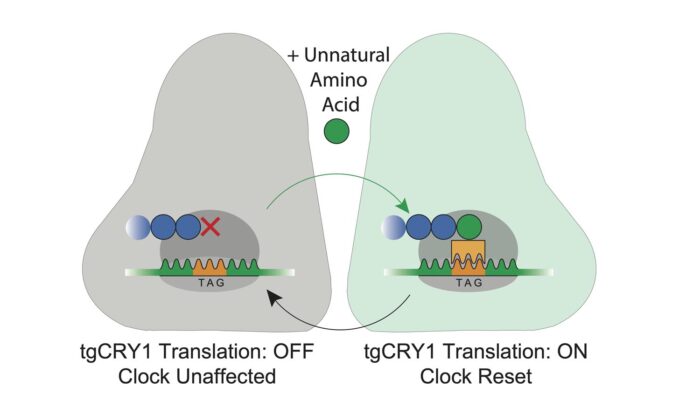Translational switching reveals daily changes in Cryptochrome 1 expression help define circadian time within the SCN

Circadian rhythms, which dominate our daily lives and are implicated in many health disorders, are governed by the suprachiasmatic nucleus (SCN) – a network of approximately 20,000 cells in the hypothalamus of the brain. SCN time keeping relies on a self-sustaining transcriptional/translational delayed feedback loop (TTFL), whereby negative regulators inhibit their own transcription. A complete day to the SCN is defined as an oscillation through a limit cycle; a trajectory that periodically progresses through successive, unique phases, as defined by a set of core components known as state variables. The exact identity of these state variables in the SCN has, so far, remained unclear. Michael Hastings’ group, in the LMB’s Neurobiology Division, have now identified the gene Cryptochrome 1 (CRY1) as a state variable of the SCN oscillator.
The group took advantage of translational switching – a method developed by Jason Chin’s group in the LMB’s PNAC Division – to reversibly, and dose dependently, control the expression of CRY1 in a living SCN slice. These organotypic slices are ideal to investigate circadian rhythms as, when cultured ex vivo, they maintain a robust circadian rhythm over a roughly 24-hour period and in effect serve as a biological clock in a dish.
David McManus, a PhD student in Michael’s group, found that acute changes in the level of CRY1 defined circadian time within the organotypic slices. This illustrates CRY1’s role as a key component – likely working alongside other contributing factors – in defining circadian time within the SCN.
This study further illuminates the inner working of the SCN. A complete understanding of the organism’s timekeeping will shed light on the interaction between circadian rhythms and health generally. This is significant as disruption of sleep and circadian rhythms is implicated in many psychiatric and mental health disorders.
This work was funded by UKRI MRC and UKRI BBSRC.
Further references
Cryptochrome 1 as a state variable of the circadian clockwork of the suprachiasmatic nucleus: Evidence from translational switching. McManus, D., Polidarova, L., Smyllie, NJ., Patton, AP., Chesham, JE., Maywood, ES., Chin, JW., Hastings, MH. PNAS
Michael’s group page
Jason’s group page
Previous Insight on Research articles
Cryptochrome proteins are integral to maintain time within the brain’s master clock
Advanced understanding of how suprachiasmatic nucleus regulates the body’s circadian rhythm